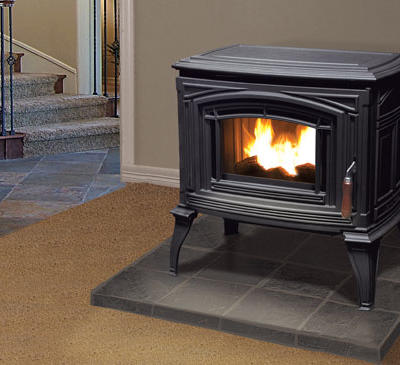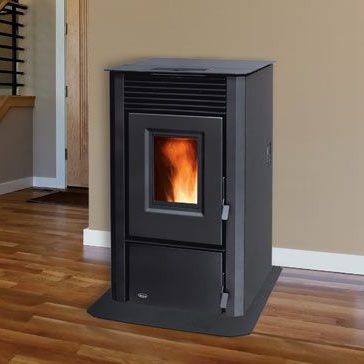Pellet stoves have risen (and decreased) in popularity over the years. Originally developed during the oil crisis of the 1970s to be affordable and convenient, a pellet stove is a smart heating system that often cut heating costs and reduces your environmental impact. The story of pellet stoves explains the ingenuity of their design.
The History of Pellet Stoves
Challenge often sparks innovation. During the tough economic times of the 1930s, Potlatch Mill in Lewiston, Idaho came up with a creative way to reuse scrap sawdust by compressing it into logs for fuel. They called these Pres-to-Logs.
A few decades later, Potlatch Mill’s innovation sparked the development of wood pellets which are smaller and made from sawdust, wood chips and other lumber mill byproducts. Since they are created from recycled wood, these pellets do not contribute to deforestation and save wood products from ending up in landfills.
Pellet stoves were created to use this renewable, recycled fuel. Their unique design was inspired by oil drum stoves and wood stoves with sawdust hoppers from the Depression-era. Unlike regular wood stoves, these stoves required less maintenance and burned more efficiently. The designers of pellet stoves improved on these designs and created a heating system that produces enough dry, radiant heat for an entire home with little environmental impact.
Innovative Design
You can find free-standing pellet stoves that are vented outside through a wall, or roof. Other models function as fireplace inserts utilizing an existing chimney. There are decorative models that allow you to appreciate the romance of a burning fire and those designed similar to regular furnaces. The real genius of their design is how they operate.
Pellet stoves are designed to produce consistent heat without the need for you to add logs or adjust the air supply. All you have to do is make sure that the hopper on your stove has enough wood pellets. The stove does the rest of the work for you.
From the hopper, an electrically operated auger feeds pellets into the combustion chamber, or burn pot. The rate pellets are dispensed at determines the temperature of the fire. Cool air from your home is drawn into the stove by a convection blower. The heated air is then circulated through your home.
In the following video Tim, one of our top technicians, demonstrates how to adjust the draft control on a pellet stove.
Please let us know if you have any questions or other video requests in the comments below.
The video features the Enviro Meridian Pellet Stove.
Pellet Stoves are Affordable Heat

The Enviro Meridian Cast Iron Pellet stove is an example of a powerful stove with a beautiful flame and bay window design.
A small amount of electricity is needed to power the convention blower and the auger. These electrically operated components of pellet stoves contribute to their efficiency and convenience relative to wood stoves. You will rarely use more than $20 of electricity a month to power your pellet stove. Your stove will require regular maintenance including cleaning the burn pot and removing ash from the ash chamber when it becomes full and refilling the hopper when it gets low (every day or two).
According to the Energy Information Administration’s Heating Fuel Comparison Calculator, wood pellets costs less than half as much as space heaters and electric furnaces to produce 1 million BTUs. You can feel good about lowering your heating bill by switching over to a pellet stove. Along with relying on a renewable, recycled fuel, pellet stoves emit little pollution. Due to the low amount of moisture in wood pellets and forced combustion, they have higher efficiency and lower emissions than wood stoves. Pellet stoves continue to be a very cost effective and enjoyable heating option in locations where consumers rely on oil, propane or electricity for heating.
Future of Pellet Stoves
There has been some innovations in the past few years (such as some pellet stoves that operate without electricity), but for the most part, the technology has to do with tweaking and improving current models. Although rumours always circulate about stoves that can operate on corn, cherry pits, coffee grinds or other biomass materials, wood pellets remain the primary heat source based on their consistency, availability, and reliability. But 5 years from now? Who can predict?
If hearing the story of pellet stoves has sparked your interest or you would like to learn more about their clever design, contact one of our specialists today! Our Friendly Fires hearth experts can help you find the best pellet stove for your heating needs & personal style.
If you’d like to learn more about the Pellets Stoves and Inserts we carry please visit The Cost Savings of Pellet.
Please leave any questions or comments below, as well as any video or blog post requests you might have!






Is there a small ( size of a 40″ tv ) pettlet stove that dont need electrity?
Hi Sherry – not that we are aware of. If there is, its not available from any of the manufacturers we represent. Good luck with your pellet stove search!